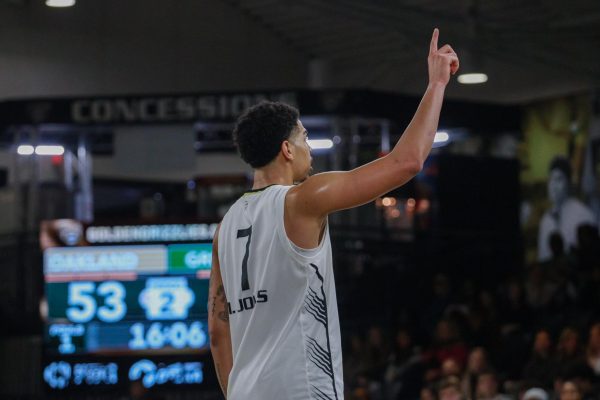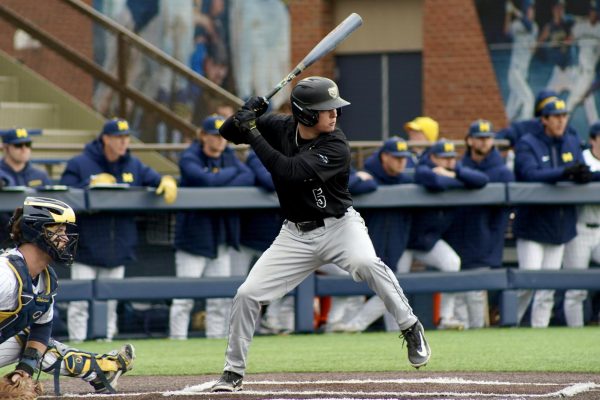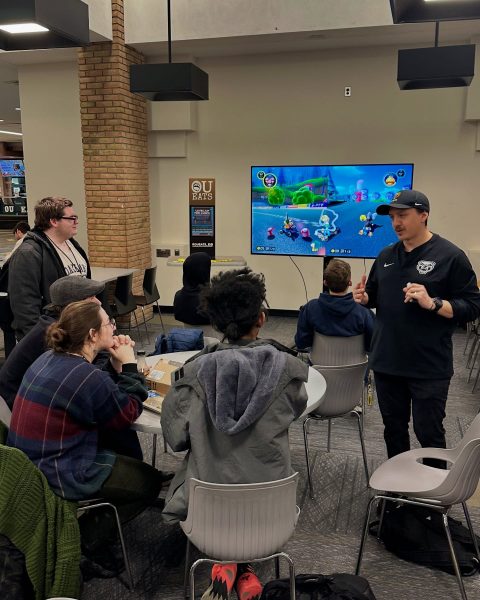Jensen’s journey to OU
When Oakland University swimmer Anders Jensen travels to College Station, Texas, this weekend to compete in the NCAA Championships, his coach’s expectations will be high.
His performance during last month’s Summit League Swimming and Diving Championships earned him Summit League Athlete of the Month honors for February, as the team captured its 10th straight conference championship.
The native of Copenhagen, Denmark, hit two NCAA automatic “A” qualifying standards in the 100 and 200-yard backstroke events, and was named Summit League Newcomer of the Year and Swimmer of the Year.
According to head swimming coach Pete Hovland, if Jensen were a typical freshman, Hovland’s expectations for the 21-year-old would be a bit more reserved. He said with a typical freshman the feeling is that you hope they do well, but you’re not really sure. But with Jensen, he feels comfortable that he won’t be as awe-struck by the event.
“He’s got international experience, he’s a little bit older, a little more mature, and this was his goal from day one,” Hovland said. “It’s not like, ‘I just hope I get there’ or ‘I’m happy to be there,’ [with Jensen].” The feeling is more like, ‘I’m going to get there and I’m going to do well when I get there. I’m going there and I’m there to swim fast or even faster.'”
Jensen believes his success is due to a strong work ethic he developed while growing up and training in Denmark, working towards his dream of swimming competitively for an American university.
Swimming Career Begins
His desire to come to America and compete at the collegiate level grew when he joined the Falkonergaardens Gymnasium elite center and experienced national recognition as he won the National Danish Junior Championships in 2006 and 2007.
In Denmark there are no college swimming teams, so for someone to pursue it professionally, they join club teams while training at elite centers.
According to Jensen, elite centers are not unlike colleges in that athletes live together in dorm-like housing where they train with other swimmers that may or may not be part of the same club team.
When he finished his four years at the elite center he sat down and converted his times to yards, because he didn’t have yard length pools in Denmark, then he sent letters to several prospective universities.
“It has been my big dream to come to the States and swim at college and still study, but it is hard to do both in Denmark,” said Jensen. “Of course you can swim, but you still go to university, it’s tougher because it’s separate and it’s on your free time.”
Jensen, who received responses from five different schools, admitted that he wasn’t aware of OU’s recent success. He said his choice to come to Oakland had more to do with the scholarship he was offered and his communication with Hovland.
“I spoke to Pete [Hovland] a lot and he was a really nice guy. I saw the team, and saw some good people I would want to train with in Marcin Unold and Edie Toro, and they were just stacked in the backstroke,” said Jensen.
Hovland equates signing Jensen to what would have been a top-ranked American swimmer.
“Anders was probably faster than any kid in high school. If he were an American kid he would have been ranked number one out of high school in the 200 backstroke, so that is like me signing the best kid in the country.”
College Life at Oakland
When Jensen moved here in August, he was a little shy, as would be expected for a 20-year-old who had never set foot on American soil.
His father joined him for the first 10 days to ease him into the reality that he would be living without his family by his side. Jensen said the hardest part was to learn to speak English every day, but the foreign presence on the team assisted in his transition.
“[The Gustafsson sisters] from Sweden could speak a little bit of Danish, and I understand Swedish so that helped. But, it was easy to speak English with my friends, but it was hard to understand teachers or formulate questions for them,” he said.
Jensen said that being around students his own age all the time helped him and according to fellow freshman and roommate Tim Montague, he adjusted to the life of a poor college student in no time.
“We’ve kind of taken a liking to $5 Fridays at Rio Wraps, and $5 Hot-N-Ready pizzas from Little Caesars. The freshman class here is really close,” said Montague.
Jensen said the American college environment made him more relaxed, and that helped his swimming.
“Being more relaxed helped my confidence, in that I can go into the water and just have fun, and do what I have to do,” Jensen said.
Wise beyond his years
Montague said that Jensen’s work ethic is really what sets him apart from the rest of the freshmen they live with.
“He’s the organized one, while I can be messy. He sometimes checks with me to see if I have my keys and stuff when we go out,” Montague said.
Jensen’s discipline is what has impressed Montague the most. He said that Jensen focuses on kicking eight times for every turn.
“He makes me feel lazy. He just has it drilled into his head that it’s just what he does, and that’s hard for a lot of swimmers to do,” Montague said. “I mean, at the that level he’s at, to have it as a no-brainer to do that, I hope to get to that level some day.”
This mentality even impressed Hovland.
“[Jensen and I] don’t get into things that deep a lot of times, so it’s interesting to hear that because it gives me a little more insight into [Jensen’s mind], because he is kind of quiet and reserved.
“His work ethic is second to none, he’s extremely focused, his approach to everything you can see, it’s calculated and thought out,” said Hovland.
His experience and maturity have made things easier for Hovland, allowing them a good working relationship, where he can ask for Jensen’s input on how to approach his training.
“A lot of freshmen come in and they have no idea, and you just say ‘look, lets just do this for this year and follow my plan, get through it, and see where we are at the end of the and adjust from there.’ With Anders it’s a partnership, where there is definitely some give-and-take, so when he does give me input I certainly listen to it, and try to implement it into what we’re doing with him.”






